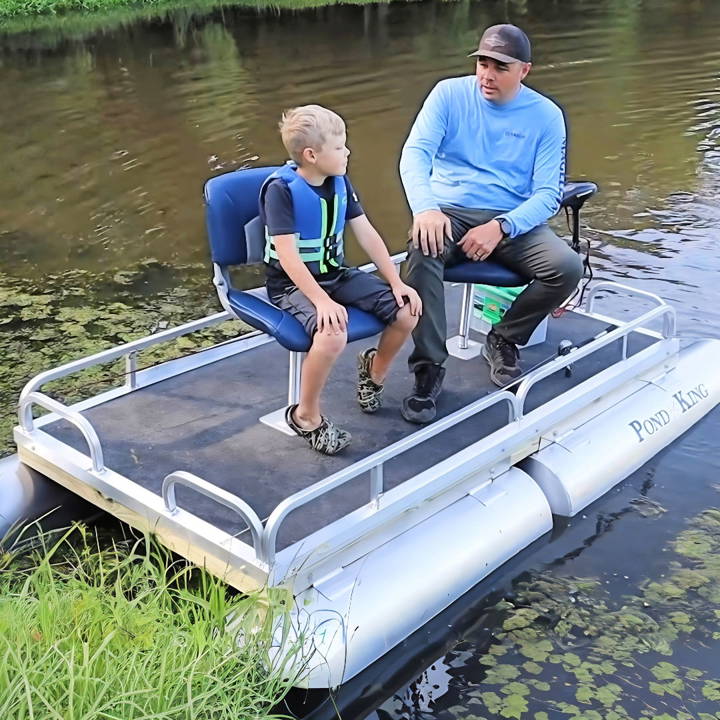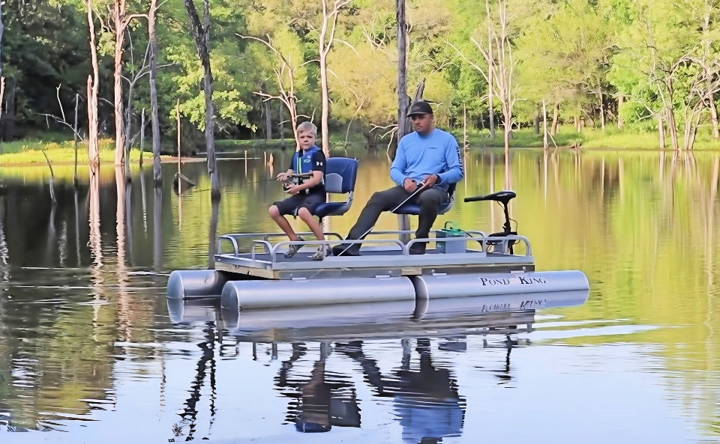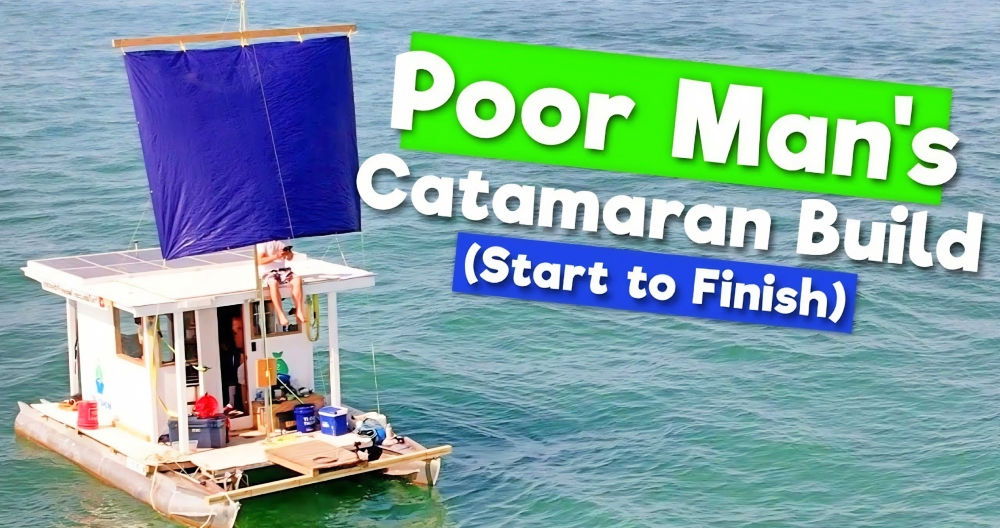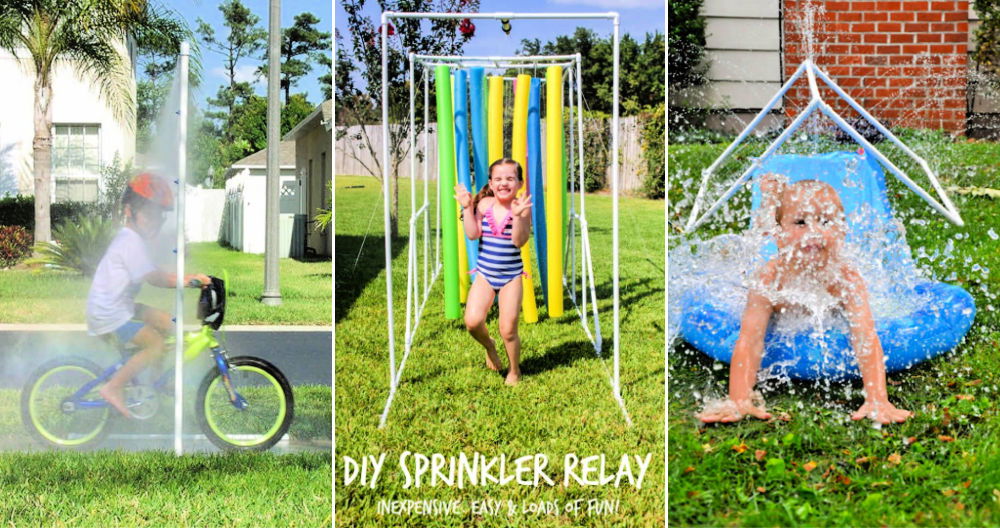Starting on the DIY pontoon boat project was both exciting and challenging for me. My family loved spending time on the water, and we dreamed of having our own boat. After lots of research and gathering materials, we started the first steps by building the frame, ensuring it was sturdy enough to support us on the lake.

Working on our homemade pontoon boat brought my family closer. We spent weekends cutting, assembling, and securing the pontoons. Each step was a learning experience, and every completed section filled us with pride.
Now, I want to share our journey and tips to help you get started. Building a pontoon boat can be a fun and rewarding DIY pontoon boat project.
Gathering the Materials: The Key to Successful Boat Building
Before embarking on this journey, I understood that having the right materials was crucial. The kit from Pond King was a godsend as it included almost everything I needed - four pontoons, a roll of carpet, all necessary hardware, and the transom mount for a trolling motor. The only things I had to source myself were the sheet of plywood for the floor, 2x4s for the frame, seats, a trolling motor, and a battery. The anticipation of putting everything together was growing, but I also felt the weight of the challenge ahead.
Why These Materials Matter
- Pontoons: The foundation of any pontoon boat. They ensure stability and buoyancy.
- Plywood and 2x4s: For the decking and structure. It needed to be strong to hold the weight and withstand water exposure.
- Carpet: To cover the plywood, making it comfortable and safer to stand on while fishing.
- Hardware and Transom Mount: Essential for assembling the boat securely and mounting the trolling motor for propulsion.
With all materials at hand, it was time to dive into the world of pontoon boat building.
Step by Step Instructions
Learn how to build a DIY pontoon boat with our step-by-step instructions. Perfect guide for making your own pontoon boat from scratch!
Step 1: Building the Frame
The first step was constructing the frame, which was, surprisingly, the most time-consuming part. However, laying out the 2x4s and cutting them to the correct lengths felt rewarding—like laying down the bones of this floating creation. The frame had to be sturdy, as it would support everything else.
Carpentry Skills to the Test
I'll admit, my carpentry skills were rusty, but this step was a fantastic refresher. Ensuring the frame was square and all corners matched up took patience and a bit of trial and error. But seeing the structure take shape was incredibly satisfying.
Step 2: Laying the Carpet
Rolling out the carpet and adhering it to the plywood was easier than I anticipated. The glue was messy, yet manageable. It reminded me, surprisingly, of crafting projects from years gone by, albeit on a much larger scale. This part of the project was about precision and ensuring there were no bubbles or lumps in the carpet—a smooth surface was critical.
The Importance of a Smooth Layer
A uniform carpet layer would not only look better but also prevent any tripping hazards while onboard. As someone who values safety as much as the fish catch, this was a step I took extra care with.
Step 3: Attaching the Pontoons
Turning the deck over to attach the pontoons was a moment of truth. This step was when the boat really began to look like a pontoon boat. Aligning the pontoons and securing them required accuracy and strength. My arms ached from the effort, but the sight of the pontoons finally attached to the deck was a shot of adrenaline.
A Test of Strength and Precision
Attaching the pontoons was a pivotal moment. It required physical effort to maneuver them into place and precision to ensure they were evenly spaced and aligned. This process transformed the collection of materials into something that resembled a real boat.
Step 4: Adding the Finishing Touches
The final steps involved mounting the trolling motor and securing the seats. Choosing the right seats and trolling motor was crucial for comfort and functionality. The trolling motor, especially, had to be powerful enough to navigate the pond but not so powerful as to be overkill for such a compact vessel.
Trolling Motor and Seats: The Difference Makers
Installing the trolling motor was a breeze, and securing the seats provided the first real taste of what using this boat would be like. I could picture early mornings on the pond, rod in hand, surrounded by peace and tranquility.
The Maiden Voyage
Launching the DIY pontoon boat into the pond was a mix of anticipation and fear. Would it float? Did I secure everything correctly? These questions raced through my mind as I gently lowered the boat into the water. As it floated, a wave of relief washed over me. The first trip on the boat was surreal—a humble concoction of wood, carpet, and pontoons gliding over the water.
A Moment of Pride and Joy
Casting the first line from the deck of a boat I built with my hands was a moment I'll never forget. The fish I caught that day was not just a testament to the richness of the pond but to the success of my endeavors.
Customization Ideas for Your DIY Pontoon Boat
Building a pontoon boat that reflects your personal style and meets your specific needs can be one of the most enjoyable aspects of the DIY process. Here are some customization ideas that can enhance the functionality and appearance of your pontoon boat:
- Fishing Upgrades: If you're an angler at heart, consider adding a fishing station complete with rod holders, a bait prep area, and a live well to keep your catch fresh. You can also install a fish finder to help locate the best spots.
- Comfort Enhancements: For those long days on the water, comfort is key. Add plush seating with waterproof cushions, a sunshade or bimini top for protection from the elements, and perhaps even a small refrigerator to keep drinks and snacks cool.
- Entertainment Features: Turn your pontoon into a party platform by installing a sound system with Bluetooth connectivity, LED lighting for evening cruises, and a swim platform with a ladder for easy access to the water.
- Eco-friendly Options: Consider the environment by opting for solar panels to power your boat's electrical systems or use recycled materials for your build. You can also install an electric motor for a quieter, emission-free experience.
- Storage Solutions: Maximize space with clever storage options. Under-seat compartments, waterproof bins, and retractable tables can keep your deck clear and your belongings dry.
- Navigation Aids: Stay safe and informed with a mounted GPS system and depth finder. These tools can help you navigate unfamiliar waters and avoid shallow areas.
- Personal Touches: Finally, make your pontoon boat truly yours with personal touches like custom paintwork, decals reflecting your interests, or even a nameplate with your boat's name.
Customize your pontoon boat to stand out and meet your needs. Planning and designing customizations carefully ensures they fit your boating lifestyle.

Troubleshooting Common Issues with DIY Pontoon Boats
When building and maintaining a DIY pontoon boat, you may encounter a variety of challenges. Here's a guide to troubleshooting some common issues, presented in a straightforward and easy-to-understand manner:
- Leaks in Pontoons: If you notice your pontoon is taking on water, check for leaks. Start by inspecting the welds and seams. Small leaks can often be repaired with marine-grade epoxy or sealant. For larger issues, you may need to weld or apply a patch.
- Unstable Decking: A wobbly deck can be a sign of loose bolts or inadequate support. Tighten all connections and consider adding additional cross beams or support brackets to reinforce the structure.
- Motor Performance Problems: If your motor isn't running smoothly, check the fuel lines for blockages and ensure the propeller is free of debris. Regular maintenance, such as changing the oil and replacing spark plugs, can also improve performance.
- Steering Difficulties: Difficulty in steering could be due to a misaligned rudder or an issue with the steering cable. Make sure the rudder is securely attached, and the cable is properly tensioned and lubricated.
- Electrical Issues: For electrical problems, start by checking the battery connections for corrosion. Use a multimeter to test the circuit continuity and replace any faulty wiring or components.
- Furniture and Fixture Damage: Exposure to the elements can damage your boat's furniture and fixtures. Repair or replace damaged items, and use marine-grade materials to prevent future issues.
- Noise and Vibration: Excessive noise or vibration often indicates a problem with the motor mount or shaft alignment. Inspect these areas and make adjustments as necessary to reduce vibration.
- Difficulty in Maneuvering: If your pontoon boat is hard to maneuver, it could be due to an uneven weight distribution. Balance the load evenly across the deck and consider adjusting the placement of heavy items.
Promptly addressing common issues keeps your DIY pontoon boat safe, functional, and enjoyable. Regular inspection and maintenance prevent many problems.
Safety Measures for DIY Pontoon Boats
Ensuring the safety of your DIY pontoon boat is paramount. Here are some key safety measures to consider:
- Buoyancy Tests: Before setting sail, perform a buoyancy test. Place your pontoon boat in shallow water and check for stability and balance. Make sure it floats evenly and doesn't tip over.
- Weight Distribution: Balance the weight on your pontoon boat. Evenly distribute passengers and gear to prevent capsizing. Avoid overloading and adhere to the weight capacity guidelines.
- Navigation Laws: Familiarize yourself with local navigation laws. These regulations govern speed limits, right-of-way rules, and areas where boating is permitted.
- Emergency Equipment: Equip your boat with essential safety gear. This includes life jackets for all passengers, a first-aid kit, a fire extinguisher, and distress signals.
- Weather Awareness: Check the weather forecast before departing. Avoid boating in severe weather conditions, and be prepared to return to shore if the weather worsens.
- Communication Devices: Carry a waterproof VHF radio or a charged mobile phone in a waterproof case. This ensures you can call for help in case of an emergency.
- Lighting and Visibility: Install proper lighting on your pontoon boat. This includes navigation lights for evening trips and reflective materials to increase visibility.
- Operator Training: Ensure the person operating the pontoon boat has adequate training. They should know how to handle the boat, navigate safely, and respond to emergencies.
By implementing these safety measures, you can enjoy a fun and worry-free experience on your DIY pontoon boat.
FAQs About DIY Pontoon Boat
Explore answers to common questions about DIY pontoon boats for materials, construction tips, and maintenance. Build your own pontoon with confidence!
A DIY pontoon boat is a custom-built watercraft consisting of a flat deck mounted on two or more metal tubes, called pontoons, which provide buoyancy. Building your own pontoon boat allows for customization to fit personal needs and preferences, often resulting in cost savings compared to purchasing a pre-built model. It’s a rewarding project that can enhance your boating skills and knowledge.
Start by determining the boat's purpose—whether it's for fishing, leisure, or water sports—and the number of passengers it will accommodate. This will guide the size and features of your design. Build detailed plans and drawings, considering the weight distribution and pontoon placement for stability and buoyancy.
Yes, even those new to boating can undertake a pontoon boat project. It requires careful planning, a bit of research, and following step-by-step instructions. There are resources and boat-building plans available that can guide you through the process.
Safety is paramount when building and operating a pontoon boat. Ensure proper weight distribution to maintain stability, use flotation devices, and install a reliable motor and steering system. Always adhere to local boating regulations and carry the necessary safety equipment on board.
Regular maintenance is key to ensure your DIY pontoon boat lasts for many years. This includes routine checks for leaks or damage, especially in the pontoons and the deck structure. Use marine-grade materials resistant to water and sun damage, and apply protective coatings to metal parts to prevent corrosion. Store your boat properly during off-seasons, and clean it regularly to avoid buildup of algae and debris.
Reflecting on the Journey
Wrapping up, constructing a DIY pontoon boat can be a rewarding and enjoyable project. By following these essential steps and tips, you will make a functional and personalized watercraft. Enjoy the process and the result, and make unforgettable memories on your homemade pontoon boat.













